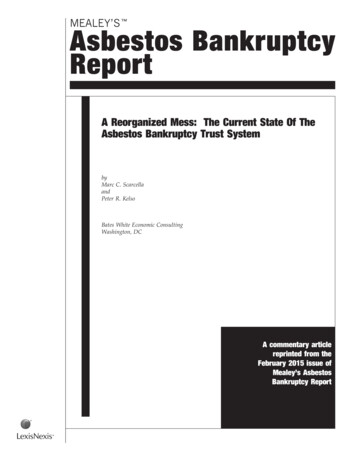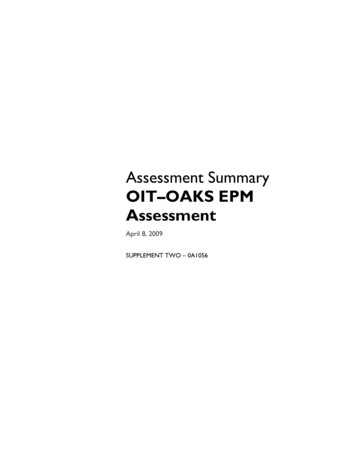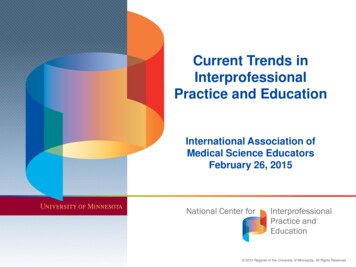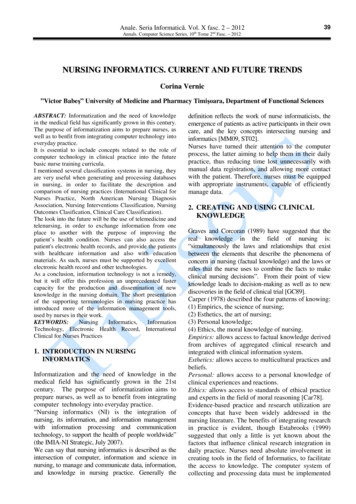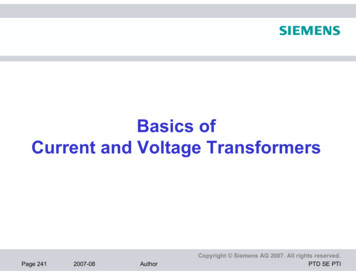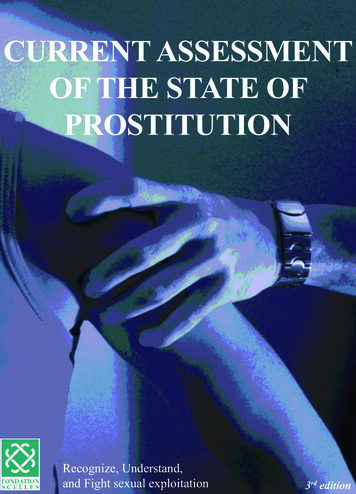
Transcription
Current Assessmentof the State ofProstitutionRecognize, Understand,and Fight sexual exploitation3rd edition
Fondation Scelles Author: Catherine GoldmannTranslation: Liv GudmundsonOriginally published asL’Exploitation de la prostitution : un fléau mondial3ème trimestre 2011
sommairea widespread commoditization of the bodyInternational prostitution: human traffickingFrom Bangkok to Paris, minors who are victims of sexual exploitationNew methods: from prostitution for survival to tradep.4p.6p.8p.9business and organized crime p.15Criminal networks and prostitutionp.16Organized crime at the heart of the States:money laundering and corruption of government officialsp.18State complicity?p.20Prostitution violence p.23Violence of prostitutionp.23Prostitution is violencep.25The broken ones: prostitution destroysp.26What public politics exist for prostitution?International institutions face prostitution: the ideological battleAbolitionism and its ambiguitiesWhen Laws Fail: Prostitution Cannot be a Profession Like Any OtherA new way: the neo-abolitionist model of SwedenShould the client be penalized?p.29p.29p.31p.33p.36p.38The Challenges of Our Fight p.40la Fondation SCELLES p.43History of the Fondation Scelles p.44Who are we? p.45Le CRIDES p.46Fondation Publications P.47To learn more P.49A Guide to Various Associations P.51Our 4 websites P.53
A WidespreadCommoditization of the BodyE., UkraineE. is 20 years old andlives in an Ukrainianvillage. She has noformal training. Nothingin particular is keepingher in the village, or inthe Ukraine. Herday-to-day life isdifficult.She seriously considersleaving. Without askinganyone for advice, sheresponds to a wantedad for a job in a foreigncountry. Followingher response, she isimmediately recruited.She quickly leaves theUkraine in a car witha man she does notknow.For nearly thirty years, we have witnessed a widespread increase inprostitution around the world. We hear of women coming from EasternEurope to prostitute themselves on the streets of our cities; we hear ofstudents selling their bodies or who auction off their virginity to pay forschool fees; we hear of all the young girls prostituting themselves totourists in bars in Thailand. Today the bodies of women, children, and nowmore often of men, are becoming commodities sold on the internet, inpeep-shows, or in brothels - in Bangkok as well as in Paris and London.This is an alarming development supported by political disruptions, theopening of borders, the impoverishment of some and the enrichment ofothers, the trivialization of pornographic images, and the internet boom.Some will say that the phenomenon is far from new. While this is true,however, with the help of globalization, sexual commerce has achievedan industrial and global dimension that is becoming more and moreworrisome. Today, the commoditization of the body appears to be theFONDATION SCELLESCurrent Assessment of the State of Prostitution4
A few days later, shefinds herself trapped in abrothel with other youngwomen in Budapest.She discovers the natureof the job for which shewas recruited, as well asthe living conditions thatare imposed upon her,depriving her of all kindsof freedoms.She is immediatelyforced into streetprostitution upon herarrival in France.ultimate development of a liberal logic without limits. Commercialized sex iseverywhere.What is Prostitution?Prostitution is the act of delivering one’s sex and body for a fee, ofmarketing sexual services and/or products legally or illegally, and ofexploiting the human body, more specifically those of women and children,with a lucrative purpose. It is also a system that organizes the exploitationand appropriation of a category of women, children, and, more and moreoften, of men. This system functions in three parts: the prostitute, the pimp,and the client. More concretely, today prostitution is made up of many pimpnetworks; it’s a real global sex industry.We estimate that there are 40-42 million prostitutes in the world (UN,2009), of which 75% are between 13-25 years old. More than nine out of tenprostitutes depend on a pimp. In Western Europe, between one and twomillion people prostitute themselves, of which a majority are immigrants andvictims of human trafficking. In the Netherlands, roughly 20,000 prostitutes(in a population of 17 million people); in Spain and Germany, hypotheticalestimates project upwards 300,000 prostitutes.In France, the least affected country in Europe according to the CentralOffice for Suppressing Human Trafficking, there are 20 000 prostitutes, ofFONDATION SCELLESCurrent Assessment of the State of Prostitution5
Markets for HumanTrafficking Des marchés d’êtresHuman traffickingmarkets exist in Europe,very close to us. Whileinvestigating Africanprostitution networks, thejournalist Olivier Enogowitnessed an auction inSwitzerland:“At dusk, our hostsblindfolded us anddrove, in the middle of aprocession of cars withtinted windows, towardsa residence in thewoods.The evening wasunfolding in a normalfashion up until themoment when guestswere invited to meet inthe “Auction Room,” inthe basement ( ). Assoon as we were settledin, girls beganparading in front us:they were naked andhad numbers on. Theypassed between therows of chairs to show offtheir most beautiful,natural assets. A bodyguard hidden behind thestage rudely directed thegirls. The bidding began( )The girl with the number9 rebelled. She no longerlistened to theorganizer’s orders: theywanted to satisfy apotential buyer whowished to try her out onthe “runway,” in frontof the crowd, beforemaking his purchase.“Get on your hands andknees, spread your legs,or I’ll beat you,” yelledthe bodyguard in aquarrelsome manner .”(Excerpt from “LesFilières africaines de laprostitution. Mémoiresd’une enquête. Paris,Ccinia communication,2007.)which around two-thirds are foreigners.Behind the numbers hides a wide range of possible situations: victims ofexploitation and networks, mothers, or students in desperate situations;French or foreigners; men, women, or children - the situations arenumerous, even if they are all attached to the same phenomenon, to thesame sex industry.1. International Prostitution: Human TraffickingMaya left Bulgaria at the age of 18. Not long before, her father beingunemployed, she had dropped out of school to work on a farm. Oneday, a friend tells her about her experience in a western country: shebabysits children and earns much more money than she ever could in Bulgaria.Maya listened to her friend and believed her. She is offered the services of atrafficker in exchange for her passport and 1,500 Dollars. She travels for twodays and two nights in a truck with no windows. She finally arrives in Italyand is immediately asked to pay for her debts. Maya refuses. She is beaten,drugged, and raped. Locked-up in a room, men come and go, one after theother, for months.Baïna was trapped in her hometown in Nigeria as a young girl, bymember of the pimping network. She was promised a job in a hair salon inEurope. At the same time, she was forced to partake in a session of “dju dju”,a sort of charm to insure her obedience. The young girl spent several monthstraveling in many countries, guided by traffickers supposedly capable ofsecuring a passport for her. In June of 2008, she flew to Paris and then tooka train to Lyon. This is where the trap tightened even further. Upon herarrival, she was “given” to Amina, who, at 23 years old, had already beenprostituting herself for 2 years, and who demanded 50,000 Euros for Baïna’stravels. Amina the “Madame” put the young girl on the street, controlledher with violence, and collected her earnings: more than 20,000 Euros!Sadly, Maya and Baina’s stories are common. In the last decades, in partbecause of a political and economic evolution, prostitution has in fact beeninternationalized. Today, prostitution is dominated by human trafficking.This phenomenon is not new. In the past, it was called “white slavery” and in1949 the United Nations clearly established a link between trafficking withpurpose of prostitution and prostitution itself: “prostitution and the evil thataccompanies it, that is to say trafficking with the intent of prostitution ”How many prostitutes are there today? Illegal by definition, thisphenomenon is not easily quantifiable and the numerous estimations oftenvary.FONDATION SCELLESCurrent Assessment of the State of Prostitution6
The Stages of Descending into HellMaki, Sierra Leone “I am 23 and come froma village in Sierra Leone.Back home, I have twochildren who are 3 and4 years old. My husbandwas the one who said Ihad to come to France,that I had to work ( ).At the airport, a man waswaiting for us.My husband told me thathe had something to takecare of and would meetup with me afterwards.He told me this manwould take care of me.But the plane landed inItaly and I was taken to ahouse where there werelots of other women. Inthat house, men wouldcome and rape us ( ).Then, a man took meand two other girls toParis. We took a nighttrain and he told us notto speak with anyone.And that if we tried toescape, he would findus, and that without him,we couldn’t do anything.In Paris, he took us toan awful hotel. He toldus the hotel was reallyexpensive and so wehad to go out on thestreets and find men; ifwe did what he told us,then they would be niceto us, feed and clothe us,and we would even beable to send money backto Africa.”They are girls or young adults, age 16-35, single, divorced, married, orsingle mothers. All are in a situation of economic insecurity, with littleeducation, and come from a broken home. Prepared to take any risksnecessary to escape, they leave their country and family in the hopesof finding a better life. Some come from Eastern European countries(Moldavia, Bulgaria, the Ukraine, or Romania) and are drawn in by joboffers in foreign countries, or are sold to traffickers by their families, theirboyfriends, or by state institutions such as orphanages.Others come from Nigeria or Ghana, two of the African countries with themost victims of human trafficking, and dream of studying in Europe, gettingmarried, and making money to bring back to their home country. Seducedby a man, or sold by their family, they will be transported to Italy, Spain, orelsewhere, and bought by networks implanted in Europe. Once they arriveat their destination, their passport is taken away and they are demanded topay back their travel debts: the girls are forced to prostitute themselves. Thisis how they find themselves on the streets of cities in Western European:Spain, Netherlands, Switzerland, France, England, Germany, Italy, Austria .Sold many times over, bid upon at auctions, “prepped” in training camps,physically and psychologically broken, exposed to the worst treatments(gang bangs, zoophilia ) they are reduced to the level of slaves. Withoutresistance, deprived of an identity and liberty, alone in a country wherethey do not speak the language, they become the property of a third partyand are controlled by a pimp. Extreme physical violence, the fear for thesafety of their families left behind, and, for young African women, the use oftraditional voodoo rituals that hurt and maintain their subordination.We define the trafficking of human beings as “ the recruitment,transportation, or housing of people, by threats, force, or other forms ofconstraint, as well as by abduction, fraud, deceit, or by abusingauthority or a situation of vulnerability, by offering or accepting payments orbenefits to obtain the consent of a person, to have authority over another viameans of exploitation” (i.e. forced work, organ donations, sexual exploitation,domestic slavery )It is important not to confuse illegal immigration with the trafficking ofhuman beings. The illicit trafficking of migrants refers to a personal andvoluntary movement, whereas the victim of trafficking is rarely in consent,or if they are, her/his consent has been obtained by force or trickery. Thetrafficking of migrants implies an illegal crossing of borders; humantrafficking, on the contrary, does not necessarily imply the samedisplacement and if there is a border crossing, it can occur legally.FONDATION SCELLESCurrent Assessment of the State of Prostitution7
2. From Bangkok to Paris, Sexual Exploitation of MinorsOf the victims of prostitution, 48% are children under 18 years old. Oneof prostitution’s characteristics today: the number of children sexuallyexploited is growing. According to UNICEF, there are around 2 millionvictims annually: girls and boys of all ages, victims of all kinds ofexploitation and sexual abuse, of whom 1.2 million will be victims of globaltrafficking. Other associations estimate numbers even higher: between 2-3million children in the world are prostitutes.This evolution is promoted by extreme poverty and client requests foryoung persons. In Thailand, at least one third of the 2 million prostitutes arechildren; they are mostly girls. In Southeast Asia, between 30-35% ofprostitutes are between 12 and 17 years old. In India, there are 270,000child prostitutes. In Latin America, 65% of children on the streets (of whichthe number is estimated at 40 million) prostitute themselves regularly oroccasionally.These children are sold off by their parents, who are often convinced ofassuring their child’s chances of finding work and a better life in aforeign country. They are raised and brainwashed by pimps whobenefit from their vulnerability because they live on the streets, comefrom a broken family, or are orphans. They are prostituted on the streets,in brothels, windows, and strip clubs, or used in pornographic films.However, it is important to not always think that this happens “elsewhere.”According to the Council of Europe (2005), 50% of trade victims are minorsin Southeast European countries. Recent reports all showed that today,Austria is the hub for the explo
they were naked and had numbers on. They passed between the rows of chairs to show off their most beautiful, natural assets. A body-guard hidden behind the stage rudely directed the girls. The bidding began ( ) The girl with the number 9 rebelled. She no longer listened to the organizer’s orders: they wanted to satisfy a potential buyer who wished to try her out on the “runway,” in .


